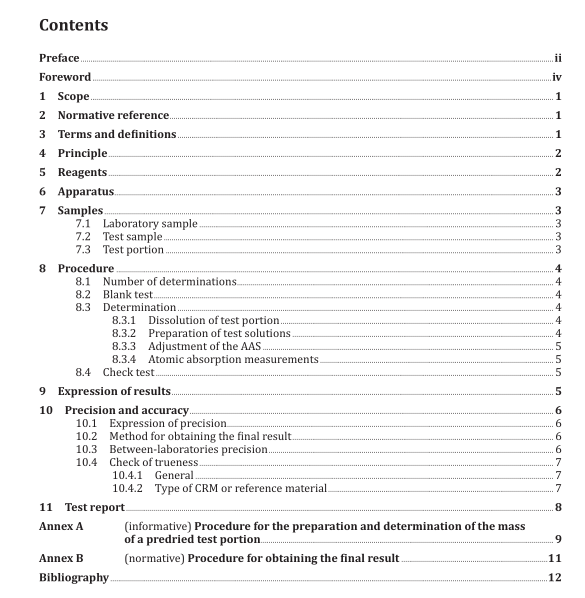AS ISO 19976.1 pdf download – Copper, lead and zinc sulfide concentrates — Determination of cadmium Part 1: Flame atomic absorption spectrometric method

AS ISO 19976.1 pdf download – Copper, lead and zinc sulfide concentrates — Determination of cadmium Part 1: Flame atomic absorption spectrometric method
5 Reagents
During the analysis, use only reagents of recognized analytical grade and distilled water or water of
equivalent purity.
5.1 Hydrochloric acid, concentrated (ρ 20 1,19 g/ml).
5.2 Hydrochloric acid, diluted 1+1.
Slowly add 500 ml of concentrated hydrochloric acid (5.1) to 500 ml of water, while stirring.
5.3 Hydrochloric acid, diluted 1+9.
Slowly add 50 ml of concentrated hydrochloric acid (5.1) to 450 ml of water, while stirring.
5.4 Nitric acid, concentrated (ρ 20 1,42 g/ml).
5.5 Hydrofluoric acid, concentrated (ρ 20 1,15 g/ml).
5.6 Perchloric acid, concentrated (ρ 20 1,70 g/ml).
5.7 Cadmium metal, minimum purity 99,99 %.
5.8 Cadmium, standard solution, 1 ml contains 1 mg of Cd.
Weigh, to the nearest 0,1 mg, 1,000 0 g of cadmium metal (5.7) into a 250 ml beaker. Add 10 ml of water and 5 ml of nitric acid (5.4). Cover and warm gently (if necessary) until the cadmium metal is dissolved. Heat to remove nitrogen oxides, then allow to cool and add about 50 ml of water. Transfer the solution to a 1 000 ml one‑mark volumetric flask, add 40 ml of hydrochloric acid (5.2), fill up nearly to the mark with water, mix and cool to room temperature, then fill up exactly to the mark with water and mix again.
5.9 Cadmium, standard solution, 1 ml contains 100 μg of Cd. Pipette 10,00 ml of cadmium standard solution (5.8) into a 100 ml one‑mark volumetric flask. Add 20 ml of hydrochloric acid (5.2), fill up nearly to the mark with water, mix and cool to room temperature, then fill up exactly to the mark with water and mix again. 5.10 Cadmium, standard solution, 1 ml contains 10 μg of Cd. Pipette 10,00 ml of cadmium standard solution (5.9) into a 100 ml one‑mark volumetric flask. Add 18 ml of hydrochloric acid (5.2), fill up nearly to the mark with water, mix and cool to room temperature, then fill up exactly to the mark with water and mix again.
5.11 Cadmium calibration solutions. Prepare a series of calibration solutions by adding, from a pipette, 0,0 ml, 2,00 ml, 4,00 ml, 6,00 ml, 7,00 ml, 8,00 ml, 9,00 ml and 10,00 ml of cadmium standard solution (5.10) into a series of 100 ml one- mark volumetric flasks. Dilute to the mark with hydrochloric acid (5.3) and mix thoroughly.
These standards contain 0,0 µg, 0,2 µg, 0,4 µg, 0,6 µg, 0,7 µg, 0,8 µg, 0,9 µg and 1,0 µg of cadmium per ml
and shall be freshly prepared.
Calibration solutions should be prepared at the same ambient temperature as that at which the determinations will be conducted.
6 Apparatus
Ordinary laboratory equipment and the following.
6.1 Volumetric glassware, of class A conforming with ISO 385, ISO 648 and ISO 1042, and used in accordance with ISO 4787.
It is permissible to use other measuring instruments, approved types, auxiliary devices and materials whose technical and metrological characteristics are not inferior to those mentioned above.
6.2 Polytetrafluoroethylene beaker, of capacity 200 ml, or glass‑carbon beaker.
6.3 Analytical balance, sensitive to 0,1 mg.
6.4 AAS, equipped with a cadmium hollow cathode lamp and deuterium lamp for background correction.
Recommended instrument conditions:
— flame: air‑acetylene;
— wavelength: 228,8 nm;
— slit width: 0,2 nm.
6.5 Insolubles filter paper, Whatman® 1) No. 40 or equivalent.









